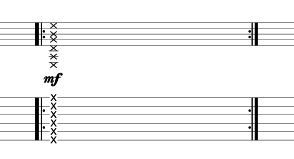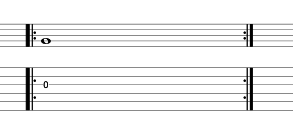
“Drummers view of the show” by Matt Deavenport, licensed under CC BY-ND 2.0.
In this popular YouTube video I created a few years ago, I talked about how to play a variety of sub-divisions and how sub-divisions are the foundation and building blocks of ALL rhythm.
In this post, we will take things a step further and get you learning all of the most important sub-divisions and I’ll show you how to practice them to take your rhythm skills to the next level.
While it is true you don’t need to fully understand them in a logical way to play them, knowing and understanding your sub-divisions certainly makes it much easier.
This is pretty much how drummers think and they have great rhythm skills. In fact, as I have stated before, the drummers who I have taught who have taken up the guitar usually make fantastic progress.
I’m not saying you should learn drums, (but if you are keen and have the time it would do your musical skills no harm) but you should try some rhythmic exercises regularly.
Once you understand your sub-divisions, you will have a true understanding of what rhythm is about (remember, ALL music has rhythm) and then you only need to practice this knowledge to be better than most guitarists out there, rhythmically speaking anyway.
The guitarists who learn about rhythm the trial and error way usually take far longer to get to where they want to be and there are usually many holes in their rhythm skills.
In this lesson, I’ll teach you from the ground level up of rhythm.
Even if you have never learnt about sub-divisions you will enjoy this lesson, as we will cover and compare the basic sub-divisions and take them to more advanced sub-divisions that will cover pretty much all your rhythm needs for a long time.
What is a sub-division?
To put it simply, it is the way we split up the beats and bars of music.
You can split them up in many ways and even combine different sub-divisions.
Instead of spending too much time defining them, here is your list of essential sub-divisions…
- Whole
- Half
- Quarter
- Eighth
- Triplets (sometimes called twelfth notes)
- Sixteenth
- Sextuplets
How to play each sub-division
Below is the description of each sub-division, with how many notes per bar they feature, how to count them when counting out loud and my recommended way of picking/strumming them.
You will also see how they look in tab form played on a muted strum as well as an open G string and you will hear the audio of them being played with a click.
Play along and master these!
I definitely recommend you practice them along with a drum beat or click at a tempo of between 40-60bpm.
That may seem slow, but once you get to the faster sub-divisions, 60bpm certainly doesn’t feel slow! Get to the last one and you will see what I mean.
Using a pick
If you play with a pick, then you will simply strum or pluck down where directed and strum or pluck up where directed.
As you will see it gets slightly trickier when playing fingerstyle…
Using your fingers
If you play fingerstyle it often depends on which string you are hitting to decide which finger to use but as our first examples are muted strums, simply strum the strings as you would normally fingerstyle. I usually recommend you use your index finger for a fingerstyle strum.
For the second example, it is played on a G string, so we use our index finger for the slower notes but when things speed up we can’t use just one finger, therefore, we will use the classical style of picking with your outer fingers first to finish with the index.
For example, for the triplet examples, you pick with three fingers, starting with the ring, then middle and then index. Read on to see this in action.
The main sub-divisions in music…
Whole
- 1 note per bar
- Count – 1 2 3 4 (play on the bold number)
- Pick – Down
- Fingerpicking – Index
- Difficulty – Easy
Half
- 2 notes per bar
- Count – 1 2 3 4 (play on the bold numbers)
- Pick – Down
- Fingerpicking – Index
- Difficulty – Easy
Quarter
- 4 notes per bar
- Count – 1 2 3 4
- Pick – Down
- Fingerpicking – Index
- Difficulty – Easy
Eighth
- 8 notes per bar
- Count – 1 & 2 & 3 & 4 &
- Pick – Down and up
- Fingerpicking – Middle then index (repeat)
- Difficulty – Fairly easy
Triplets
- 12 notes per bar
- Count – 1 trip let 2 trip let 3 trip let 4 trip let
- Pick – All downs OR downs and ups – the key is to hit the ones on the beat harder
- Fingerpicking – Ring, middle then index (repeat)
- Difficulty – Very tricky at first
Sixteenth
- 16 notes per bar
- Count – 1 e & a 2 e & a 3 e & a 4 e & a
- Pick – down and up
- Fingerpicking – Middle then index (repeat)
- Difficulty – Tricky at first
Sextuplets
- 24 notes per bar
- Count – 1 e dad e mom e
- Pick – downs and ups – the key is to hit the ones on the beat harder
- Fingerpicking – Ring, middle then index (repeat)
- Difficulty – Very tough at first especially at speeds above 60bpm
Tips on using and playing them
Many guitarists struggle with playing the more complex sub-divisions in time.
A simple tip to help prevent this is to hit the notes on the beats harder than the rest. In other words, any strum or pluck that falls on the beats of 1 2 3 4.
What you need to do is practice each of those sub-divisions to either a drum beat or click over and over so each one is in precise time.
Then, when you are good, start switching between the different sub-divisions using just one note or one chord.
Single notes can be easier to practice these on than chords as chords require you to strum in a wider range of motion due to there being more than one string being strummed whereas single notes obviously require a small range of motion due to one string being plucked.
Now, improve your rhythm skills and master these sub-divisions
That’s our primer of getting good at playing the most important sub-divisions on the guitar. This lesson is all about understanding what sub-divisions are and what they sound like.
I go through the most important of these in my course on strumming and teach you them in the context of strumming but sub-divisions aren’t just about strumming. They cover every single aspect of music.
That is why it is important to be able to master them and change between them effortlessly. It does take time but is well worth it as your rhythm will be tighter, your playing more exciting and the audience will certainly notice how tight you are as a guitarist.
In a future lesson, we will look at some really practical techniques for putting them together and improving them, (which will sky-rocket your sense of rhythm) as well as some ways to use them in a very musical setting.
Combining them, mixing and matching them and playing about with grooving these sub-divisions is key.
Play about with these rhythms over chords, (be it using fingerpicking patterns or strumming patterns), melodies, off-beat grooves, chord extensions or percussive hits.
Those are just some of the ways you can use them right away, but this will be covered more in a future lesson.
Whenever you want to improve your sense of rhythm, this lesson is the place to start as it covers pretty much most of the rhythms you will ever need.















Add Comment